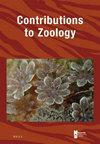实验室条件下千足虫Megaphyllum unilineatum(C.L.Koch,1838)(Myriapoda,Diplopoda,Julida)的形态和交配行为
IF 2.2
2区 生物学
Q1 ZOOLOGY
引用次数: 0
摘要
虽然形态变异可能对行为有影响,但只有少数关于千足虫的研究探讨了某些形态特征的变异对交配成功的影响。因此,本研究的目的是调查实验室条件下的交配行为,并确定可能成为单线巨兽交配前选择目标的性状。行为序列通过三种类型的测试进行量化:交配竞技场测试、女性选择测试和男性选择测试。虽然与第一个选择的伴侣(从交配场所测试中)的接触次数比在选择测试中新提供的个体要多,但性选择系数的值并没有在统计上证实这种偏好。此外,还对不同交配状态个体的线性测量(躯干高度和宽度、全身长度、触角、行走腿和性腺鞭毛)进行了分析,并对这些个体的触角、头部、行走腿、性腺巨端和喙部的大小和形状进行了几何形态测量分析。触角的长度和形状、头的形状和行走的腿的形状在不同的交配状态下有显著的差异。在不同交配状态的雄性中,只有前质心大小具有统计学意义。在某些行为序列的差异中,单线支原体与先前报道的波斯尼亚支原体相似,而在上述物种的形态变异中未发现这种相似性。本文章由计算机程序翻译,如有差异,请以英文原文为准。
Morphology and mating behaviour in the millipede Megaphyllum unilineatum (C.L. Koch, 1838) (Myriapoda, Diplopoda, Julida) under laboratory conditions
Although morphological variation may have an effect on behaviour, there are only a few studies on julid millipedes in which the influence of the variability of some morphological traits on mating success has been explored. Hence, objectives of this study were to investigate mating behaviour in laboratory conditions and identify traits that could possibly be the target of pre-copulatory selection in the julid species Megaphyllum unilineatum. Behavioural sequences were quantified in three types of tests: a mating arena test, a female choice test, and a male choice test. Although the number of contacts with the first chosen partner (from the mating arena test) was greater than with newly offered individuals in choice tests, values of the sexual selection coefficient did not statistically confirm this preference. In addition, analyses of linear measurements (trunk height and width, length of the whole body, antennae, walking legs, and gonopod flagella) in individuals of different mating status were also conducted, as well as geometric morphometric analyses of size and shape of the antennae, heads, walking legs, and gonopod promeres and opisthomeres in such individuals. Antennal length and shape, head shape, and the walking legs shape, differed significantly, depending on the mating status of females. In males of different mating status, statistical significance was established only in the promere centroid size. The differences in certain behavioural sequences in M. unilineatum are similar to those previously reported in M. bosniense, while such similarity is not detected with respect to morphological variation in the mentioned species.
求助全文
通过发布文献求助,成功后即可免费获取论文全文。
去求助
来源期刊

Contributions to Zoology
生物-动物学
CiteScore
4.00
自引率
4.50%
发文量
16
审稿时长
>12 weeks
期刊介绍:
Contributions to Zoology solicits high-quality papers in all systematics-related branches of comparative zoology (including paleozoology). Preference will be given to manuscripts dealing with conceptual issues and to integrative papers (e.g., ecology and biodiversity, morphology and phylogeny and character state evolution, phylogeny and historical biogeography, systematics and bioinformatics, bioinformatics and biodiversity, habitat disturbance and biogeography, etc.). Reviews and alpha-taxonomic contributions are considered for publication, but acceptance will depend on their high quality and exceptional nature.
 求助内容:
求助内容: 应助结果提醒方式:
应助结果提醒方式:


